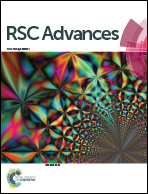Enhancement of water and organic solvent resistances of a waterborne polyurethane film by incorporating liquid polysulfide
Abstract
Environmentally friendly, waterborne polysulfide-based polyurethane (WSPU) films have been successfully synthesized from liquid polysulfide (PSF), polytetramethylene ether glycol (PTMG), isophorone diisocyanate (IPDI) and dimethylolpropionic acid (DMPA). The chemical structures, mechanical and thermal properties of the chemically modified films have been carefully investigated using ATR-IR, gel permeation chromatography (GPC), tensile tests, dynamic mechanical analysis (DMA) and a thermogravimetric analyzer (TGA). As the PSF content increases from 0 to 20%, after an immersion in deionized water for 96 h, the water absorption decreases from 6.2% to 3.4% and the tensile strength retention increases from 74.3% to 91.7%. The chemical resistance to organic solvents is also improved significantly. The enhanced water and organic solvent resistances of waterborne polyurethanes (WPUs) are primarily attributed to the addition of a PSF containing sulfur group. However, the tensile strength and thermal performance are weakened to some extent. This study produces a new composite derived from polysulfide, and its high water and solvent resistance performance could contribute to surface material research.


 Please wait while we load your content...
Please wait while we load your content...